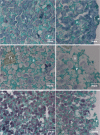Structural, Culinary, Nutritional and Anti-Nutritional Properties of High Protein, Gluten Free, 100% Legume Pasta
- PMID: 27603917
- PMCID: PMC5014310
- DOI: 10.1371/journal.pone.0160721
Structural, Culinary, Nutritional and Anti-Nutritional Properties of High Protein, Gluten Free, 100% Legume Pasta
Abstract
Wheat pasta has a compact structure built by a gluten network entrapping starch granules resulting in a low glycemic index, but is nevertheless unsuitable for gluten-intolerant people. High protein gluten-free legume flours, rich in fibers, resistant starch and minerals are thus a good alternative for gluten-free pasta production. In this study, gluten-free pasta was produced exclusively from faba, lentil or black-gram flours. The relationship between their structure, their cooking and Rheological properties and their in-vitro starch digestion was analyzed and compared to cereal gluten-free commercial pasta. Trypsin inhibitory activity, phytic acid and α-galactosides were determined in flours and in cooked pasta. All legume pasta were rich in protein, resistant starch and fibers. They had a thick but weak protein network, which is built during the pasta cooking step. This particular structure altered pasta springiness and increased cooking losses. Black-gram pasta, which is especially rich in soluble fibers, differed from faba and lentil pasta, with high springiness (0.85 vs. 0.75) and less loss during cooking. In comparison to a commercial cereal gluten-free pasta, all the legume pasta lost less material during cooking but was less cohesive and springy. Interestingly, due to their particular composition and structure, lentil and faba pasta released their starch more slowly than the commercial gluten-free pasta during the in-vitro digestion process. Anti-nutritional factors in legumes, such as trypsin inhibitory activity and α-galactosides were reduced by up to 82% and 73%, respectively, by pasta processing and cooking. However, these processing steps had a minor effect on phytic acid. This study demonstrates the advantages of using legumes for the production of gluten-free pasta with a low glycemic index and high nutritional quality.
Conflict of interest statement
The authors have declared that no competing interests exist.
Figures



References
-
- Marti A, Pagani MA. What can play the role of gluten in gluten free pasta? Trends in Food Science & Technology. 2013; 31(1): p. 63–71.
-
- Jenkins DJA, Wolever TMS, Jenkins AL, Lee R, Wong GS, Josse R. Glycemic response to wheat products—reduced response to pasta but no effect of fiber. Diabetes Care. 1983; 6(2): p. 155–159. - PubMed
-
- Bjorck I, Liljeberg H, Ostman E. Low glycaemic-index foods. British Journal of Nutrition. 2000; 83: p. S149–S155. - PubMed
MeSH terms
Substances
LinkOut - more resources
Full Text Sources
Other Literature Sources

